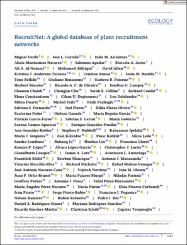RecruitNet: A global database of plant recruitment networks

Göster/
Erişim
info:eu-repo/semantics/openAccessTarih
2023Yazar
Verdú, MiguelGarrido, Jose L.
Alcántara, Julio M.
İpekdal, Kahraman
Manrique, Esteban
Manzaneda, Antonio J.
Marcilio-Silva, Vinicius
Üst veri
Tüm öğe kaydını gösterKünye
Verdú, M., Garrido, J. L., Alcantara, J. M., Montesinos‐Navarro, A., Aguilar, S., Aizen, M. A., ... & Zamora, R. (2023). RecruitNet: A global database of plant recruitment networks.Özet
Plant recruitment interactions (i.e., what recruits under what) shape the composition, diversity, and structure of plant communities. Despite the huge body of knowledge on the mechanisms underlying recruitment interactions among species, we still know little about the structure of the recruitment networks emerging in ecological communities. Modeling and analyzing the community-level structure of plant recruitment interactions as a complex network can provide relevant information on ecological and evolutionary processes acting both at the species and ecosystem levels. We report a data set containing 143 plant recruitment networks in 23 countries across five continents, including temperate and tropical ecosystems. Each network identifies the species under which another species recruits. All networks report the number of recruits (i.e., individuals) per species. The data set includes >850,000 recruiting individuals involved in 118,411 paired interactions among 3318 vascular plant species across the globe. The cover of canopy species and open ground is also provided. Three sampling protocols were used: (1) The Recruitment Network (RN) protocol (106 networks) focuses on interactions among established plants (“canopy species”) and plants in their early stages of recruitment (“recruit species”). A series of plots was delimited within a locality, and all the individuals recruiting and their canopy species were identified; (2) The paired Canopy-Open (pCO) protocol (26 networks) consists in locating a potential canopy plant and identifying recruiting individuals under the canopy and in a nearby open space of the same area; (3) The Georeferenced plot (GP) protocol (11 networks) consists in using information from georeferenced individual plants in large plots to infer canopy-recruit interactions. Some networks incorporate data for both herbs and woody species, whereas others focus exclusively on woody species. The location of each study site, geographical coordinates, country, locality, responsible author, sampling dates, sampling method, and life habits of both canopy and recruit species are provided. This database will allow researchers to test ecological, biogeographical, and evolutionary hypotheses related to plant recruitment interactions. There are no copyright restrictions on the data set; please cite this data paper when using these data in publications. © 2022 The Authors. Ecology published by Wiley Periodicals LLC on behalf of The Ecological Society of America.

















